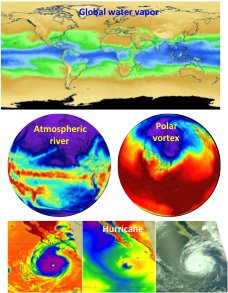Atmospheric Physics And Weather

The Atmospheric Physics and Weather Group carries out weather and climate research, studying processes and phenomena related to moist thermodynamics and the hydrologic cycle in the atmosphere. These range from small-scale processes such as convection, clouds and precipitation to large-scale phenomena such as tropical cyclones, severe storms, atmospheric rivers, and climate-variability phenomena such as the Madden-Julian Oscillation, ENSO, and monsoons, as well as global climate trends.
Key science questions our group is focused to addressing include:
- How do small-scale weather processes interact with the large-scale thermodynamic environment?
- What controls the intensity, distribution and likelihood of convective storms, and how can we use satellite observations to improve modeling and prediction of important weather events?
- How well do climate models compare to observations, and how can we use global satellite observations to improve the models?
- What phenomena relevant to our research themes are not adequately observed and require new observing strategies and systems to be developed?
Atmospheric Physics And Weather: Missions and Projects
- S-NPP satellite
- MODIS on Aqua
- CALIPSO
- GPM
- Field campaigns (GRIP, HS3, SHOUT etc.)
- SERVIR
- MEaSUREs
- NEWS
- AIRS
- CloudSat
- SMAP
Our areas of expertise include the following:
- Retrieval algorithm development
- Climatology development
- Weather and climate model evaluation
- Spectroscopy
- Cloudy radiative transfer models
- Applications
- Aircraft-based field experiments
- Advanced infrared and microwave sounders
Our group works closely with AIRS and uses data from CloudSat and SMAP.
We provide most of the science support for AIRS at JPL, which includes algorithm and product development and validation. We provide similar services for the S-NPP sounder suite (CrIS and ATMS). A large portion of our work consists of research funded through NASA’s R&A program. We are also involved in the development of future space instruments to measure atmospheric phenomena, with focus on infrared and microwave temperature and water vapor sounders, ranging from miniature sensors suitable for CubeSat missions to large sensors suitable for geostationary satellites.